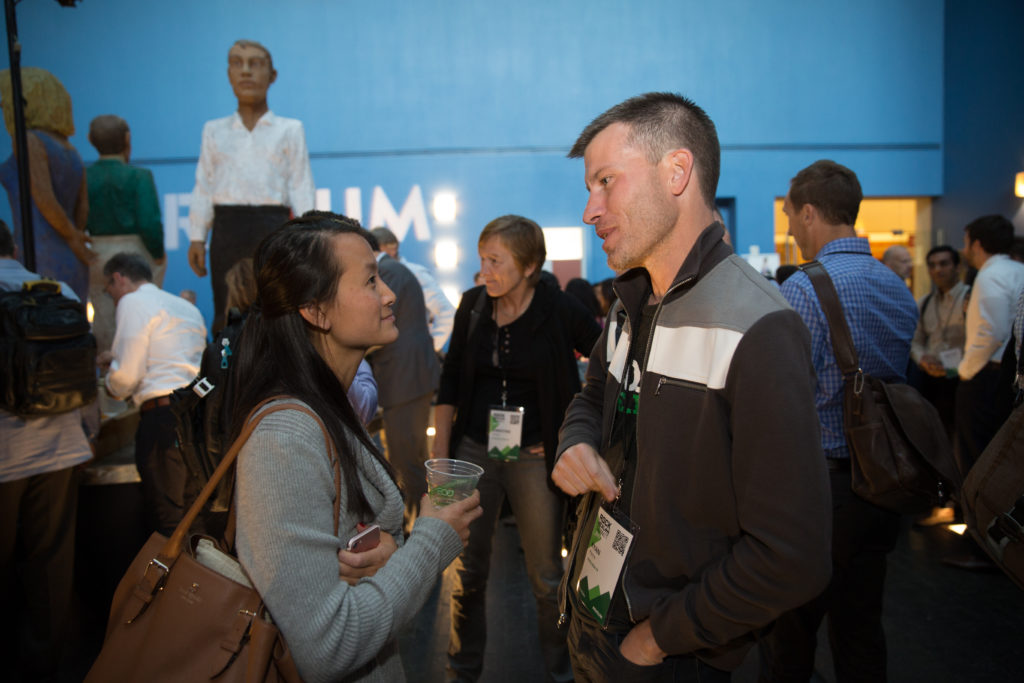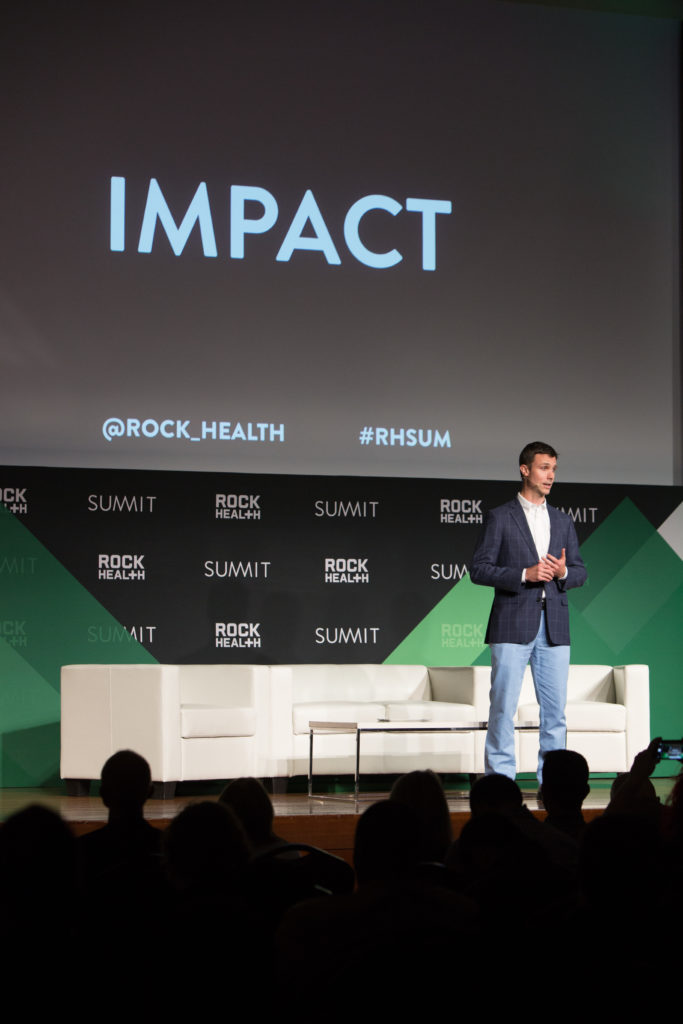What digital health’s middle innings require: lessons from Rock Health Summit 2017

Though we have a long way to go, digital health is no longer in its infancy. Since Rock Health began tracking digital health deals in 2011, over $22B in funding has poured into the sector—and beyond the staggering figures, the burgeoning number of entrepreneurs, growing cohort of matured companies, and increased stakeholder engagement all indicate digital health is at an inflection point between the early days of possibilities and the future of fully-realized potential. Last month we brought together a diverse group of over 600 individuals across healthcare and beyond for our sixth Rock Health Summit to get to the heart of what exactly digital health’s ‘middle innings’ require.
With over thirty speakers exploring everything from cross-industry collaboration to the opioid crisis, a number of key themes emerged—but one thread tied them all together: having a keen eye for impact and how to ensure outcomes materialize. As digital health matures, we must commit to identifying and pursuing solutions that can deliver impact—and measure success based on the impact actually delivered. Here’s a handful of important takeaways we gathered from the innovators and professionals on the frontlines of healthcare:
The most overhyped and most promising technology in healthcare? You guessed it—AI
This sentiment came through loud and clear at many points throughout the Summit, both onstage and from within the audience. Live polls conducted with attendees revealed that AI is viewed as both the most overhyped technology in healthcare and the technology with the most promise to transform it. Also confirmed by experts in the field—AI isn’t coming for your doctor’s jobs, nor can it wholly replace the power of human connection so essential to health care. Stanford School of Medicine Dean Lloyd Minor sees a future of “high tech enabling high touch care.” So how can we work to uncover the real value of AI in healthcare?
Verily’s Jessica Mega and Flatiron Health CMO Amy Abernethy pointed to two specific use cases—early detection of diabetic retinopathy and improved patient care in oncology, respectively. AI pioneer and leading Stanford University researcher Andrew Ng has been known to bestow AI with the title of “the new electricity.” During his fireside chat, he explained why healthcare in particular is presently primed for its AI revolution—following the data flow enabled by the IT revolution, artificial intelligence can be applied meaningfully and broadly. He has doubled down on his beliefs, announcing his move to bring AI to mental health as chairman of Woebot.
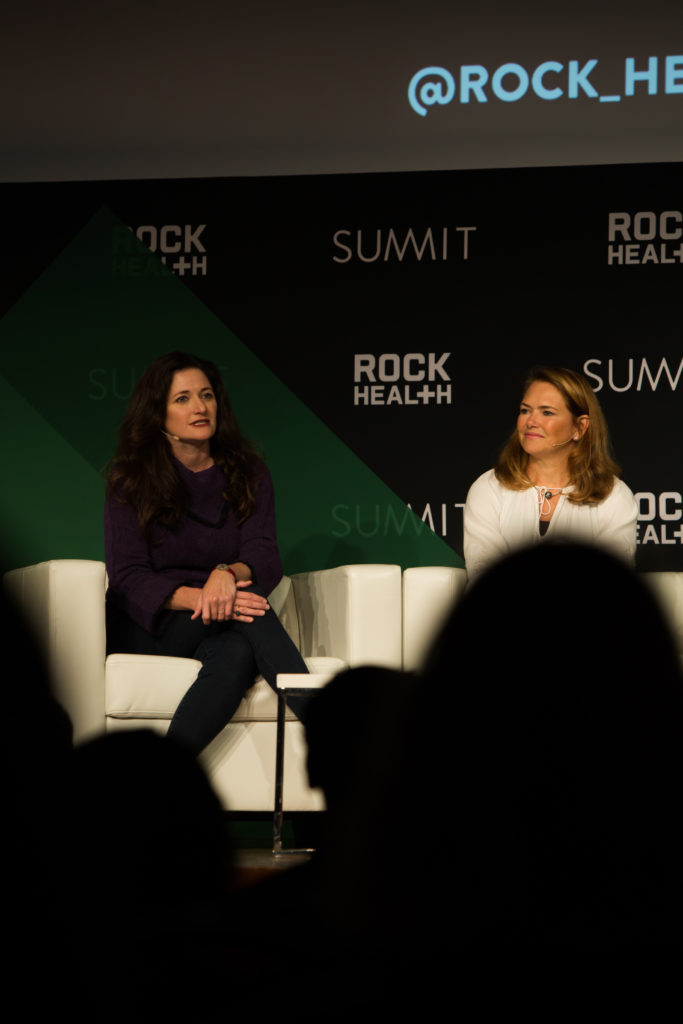
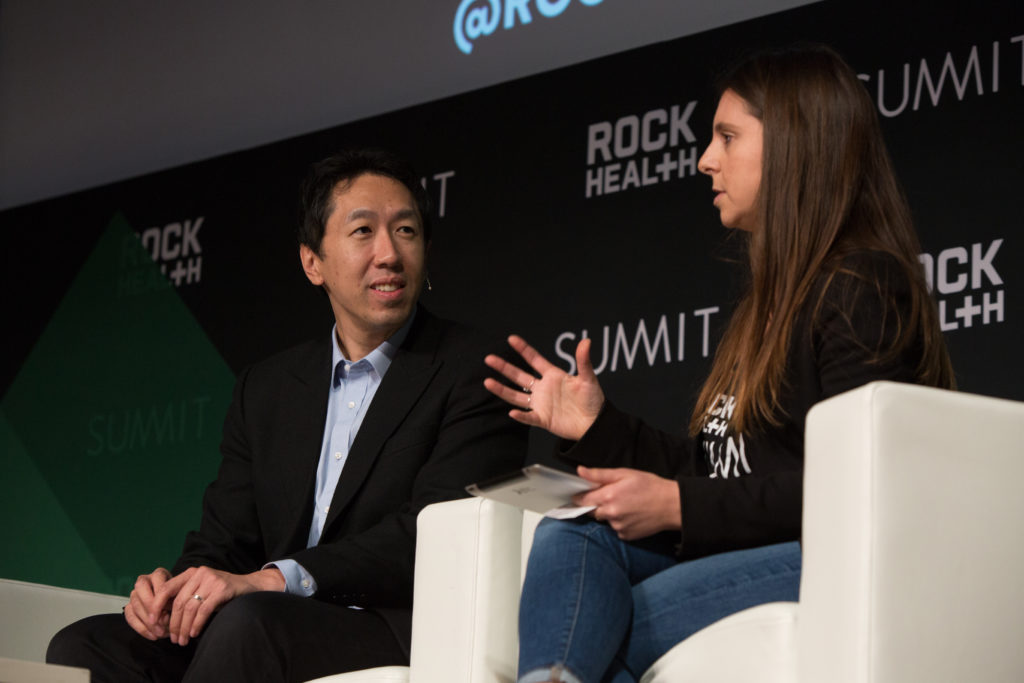
A word to the wise: avoid the shiny object problem
The technology industry has a penchant for the latest and greatest gadgets, but just because you build a sleek product doesn’t mean anyone is going to use it. And when it comes to underserved groups, “those things don’t stick,” explained Veenu Aulakh, Director of the Center for Care Innovations. In her work with underserved populations, she looks at the population’s unique needs and works backward to find solutions. So many products on the market and in development are geared toward commercial populations, but there is a huge unmet need within our nation’s safety net population—and it’s critical to test digital health solutions within those groups, too.
Sean Duffy of Omada Health echoed the importance of this process, reminding innovators to fall in love not with the technology, but instead with the problem they’re solving. Above all, it’s critical to take a deliberate step back from the outset to assess your solution’s potential for impact—and recognize when it may simply be adding to the noise. “Digitization of ineffective traditional point solutions isn’t success,” cautioned Toyin Ajayi, Chief Health Officer of Cityblock Health.
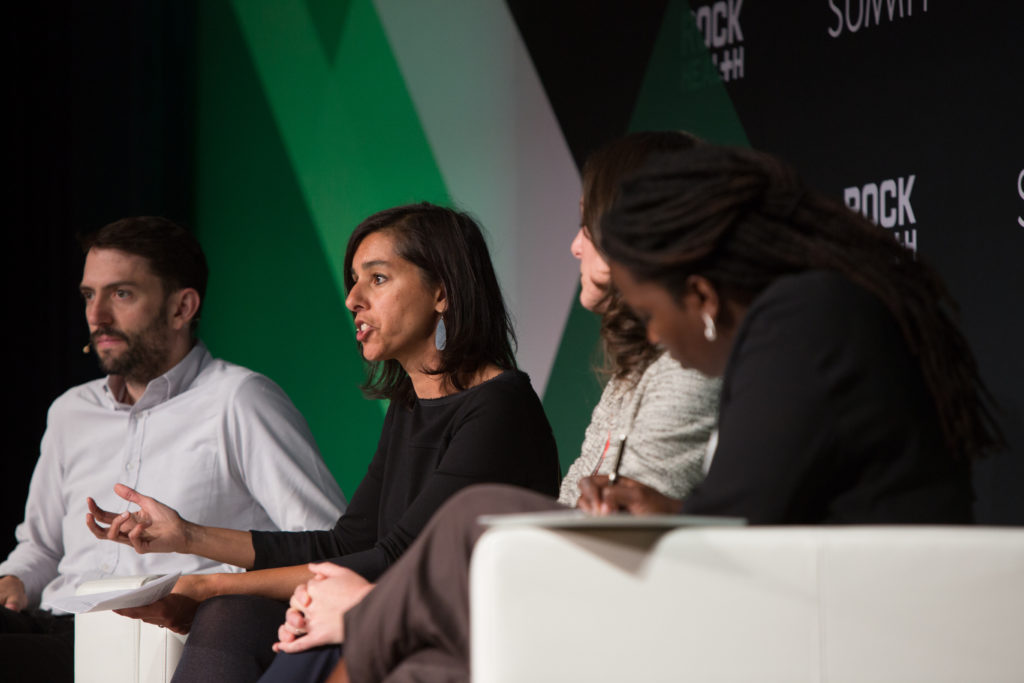
Design your solution with the social determinants of health top of mind
Those familiar with core public health principles exchanged knowing looks as speakers reiterated the priority of addressing social determinants of health when building digital solutions. Now more than ever, some of the biggest opportunities for entrepreneurs are found in innovations for the Medicaid population and lower income Americans. Solutions that help high-need, high-cost individuals access and navigate the healthcare system are largely missing from the scope of digital health products today—at great cost to both their health and the system at large. What works for the common consumer will often not be effective for people with complex care needs. Designing tools to assist with issues like medication management, appointment coordination, and simply tracking Medicaid eligibility status should be done with consideration of the social circumstances of these populations—and above all, empathy for how their experiences shape their interactions with the healthcare system.
While an obvious area of need (and opportunity), it is also rife with challenges—and as a result, many are reluctant to dive headfirst into the Medicaid market. Sometimes traditional metrics such as ROI (return on investment) aren’t relevant when making the business case for tools addressing the needs of the underserved. However, this is not reason enough to walk away—as Veenu Aulakh notes, “You can make an argument around how much you’re improving employment rates, or other more creative measures.”
Former CMS Administrator and current Bipartisan Policy Center Senior Advisor Andy Slavitt surmised, “Our problem as a country is not with the 65-year-old jogger with two Fitbits—it’s the person who lives two blocks from the dialysis center and misses the bus to her appointment. We’re capable of providing good care in this country. Put your efforts into improving the logistics of healthcare.” Technology isn’t the end-all—the tools are one part of the equation, but some of it is really simple coordination and community-based resource use.
Follow the bipartisan path to healthcare innovation
In conversation with Omada Health’s Lucia Savage, Andy Slavitt both shared the depths of his policy knowledge and framed the bipartisan outlook on healthcare innovation. Despite the polarized state of American politics today, the reality is innovation is popular on both sides—and in order to successfully bring innovation to the government, there are a few things Slavitt suggested entrepreneurs can do.
It’s imperative to tell a story of success and, most importantly, have data to show for it—a meaningful demonstration of your value-add in specific use cases. “Treat the government like it’s a trillion dollar budget problem,” advised Slavitt. “If this gives people better care, closer to home and at lower costs, everyone is interested in that.” While engagement in policy is crucial, innovators should also get out of their hubs, engage in the community, and listen—and evolve their products.
What’s the perfect health policy to solve all the problems? As it turns out, that’s not the right question to be asking. “It’s far more important that we can actually implement policy—and to have something to implement, we need something that both parties have their fingerprints on,” said Slavitt. “I don’t think these are party issues—they’re kitchen table issues. Forget who wins and who loses and ask a different question. Does the American public benefit?”
FDA’s Bakul Patel has a piece of advice for entrepreneurs: If you’re a software-based therapeutic, you should talk to the FDA as soon as possible. But first, see what kind of products have been approved, learn what decisions have already been made, and be familiar with those examples first. “Knowing where you are in the spectrum is really helpful,” Bakul said. Didn’t make the cut for the agency’s Pre-cert pilot? They still want to hear from you—reach out to digitalhealth@hhs.gov. “We’re literally crowdsourcing these standards. No one person has the answer. We’re trying to answer: What’s usable, practical, and reasonable in real life?”
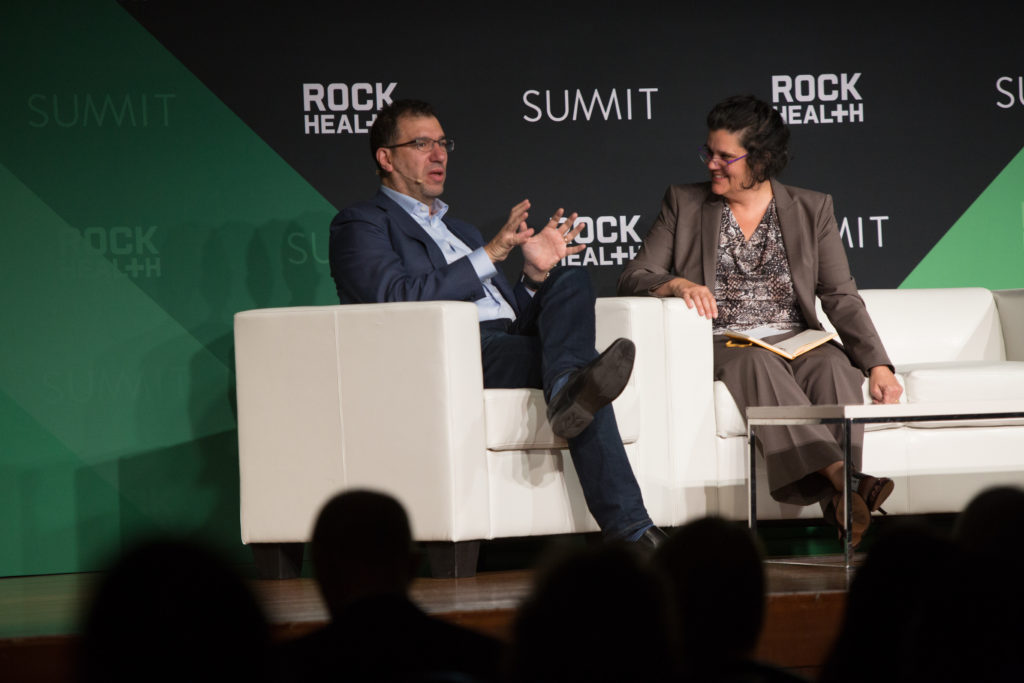
A grab bag of takeaways
On the current state and future of digital health
Noting startups’ growing pains within an entrenched industry over the years, our own Bill Evans cited recent Rock Health research that shows strong proclivity to shift to B2B in digital health—only 14% of surveyed startups currently employ a B2C business model.
Cross-industry collaboration in action
In the wake of the recent Northern California wildfire devastation, Chris Waugh, Chief Innovation Officer at Sutter Health, shared about the hospital system’s partnerships with Lyft, providing free rides to hospitals for patients and employees. This was a clear example of finding existing solutions to solve crises—as Veenu Aulakh recommends. Outside industries should look to bring their unique strengths to problems in healthcare and collaborate with both incumbents and innovators alike. Heather Jordan Cartwright, General Manager of Healthcare NExT at Microsoft, described this as a wise business move: “That’s a mindshift we need to embrace in the industry—it’s not losing market share, it’s gaining insight and being able to operate more effectively.”
Keep an eye on our YouTube channel and Facebook page for videos and photos from the Summit.
